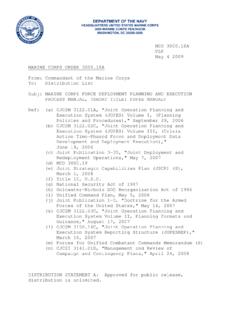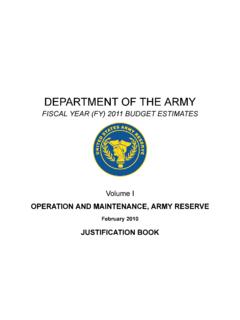Transcription of CUSTOMS AND COURTESIES - GlobalSecurity.org
1 CHAPTER 9 CUSTOMS AND COURTESIESThe military services have a long history. Manytraditions have been established as a result of this longhistory. If you are familiar with some of these traditions,you will understand the military better. These traditionscan be broken down into various CUSTOMS custom is a way of acting a way that hascontinued consistently over such a long period that it hasbecome like law. A courtesy is a form of polite behaviorand excellence of manners. You will find that Navy lifecreates many situations, not found in civilian life, thatrequire special behavior on your part. CUSTOMS andcourtesies help make life orderly and are a way ofshowing are regular, expected actions. They havebeen repeated again and again and passed from onegeneration to the next. Courteous actions show yourconcern and respect for others and for certain objects orsymbols, such as the American use of CUSTOMS , COURTESIES , and ceremonieshelps keep discipline and order in a militaryorganization.
2 This chapter will give you some of themore common day-to-day CUSTOMS and COURTESIES andways to deal with CUSTOMSL earning Objective: When you finish this chapter, youwill be able to Recognize the purpose of military time to time, situations arise that are notcovered by written rules. Conduct in such cases isgoverned by CUSTOMS of the service. CUSTOMS areclosely linked with tradition, and much esprit de corpsof the naval service depends on their continuedmaintenance. (Custom has the force of law; usage ismerely a fact. There can be no custom unlessaccompanied by usage.)A custom is a usual way of acting in givencircumstances. It is a practice so long established that ithas the force of law. An act or condition acquires thestatus of a custom under the following circumstances: When it is continued consistently over a longperiod When it is well defined and uniformly followed When it is generally accepted so as to seemalmost compulsory When it is not in opposition to the terms andprovisions of a statute, lawful regulation, ororderMILITARY COURTESIESL earning Objectives: When you finish this chapter,you will be able to Identify how to, when to, and to whom to renderthe hand and rifle salute.
3 Identify the military COURTESIES when ship andboat passing honors are an act or verbal expression ofconsideration or respect for others. When a person actswith courtesy toward another, the courtesy is likely to bereturned. We are courteous to our seniors because weare aware of their greater responsibilities and are courteous to our juniors because we are aware oftheir important contributions to the Navy s the military service, and particularly in the Navywhere personnel live and work in close quarters,courtesy is practiced both on and off duty. Militarycourtesy is important to everyone in the Navy. If youknow and practice military courtesy, you will makefavorable impressions and display a self-assurance thatwill carry you through many difficult situations. Acts of9-1It rests with us to make the traditions and to set the pace for those who are tofollow and so upon our shoulders rests a great responsibility.
4 Esther Voorhess Hasson,First Superintendent, Navy Nurse corps , 1908respect and courtesy are required of all members of thenaval service; the junior member takes the initiative, andthe senior member returns the required act of military courtesy is the governing its use are founded on militarycustom deeply rooted in tradition. The salute is asymbol of respect and a sign of comradeship amongservice personnel. The salute is simple and dignified;but, there is great significance in that gesture. It is atime-honored demonstration of courtesy among allmilitary personnel that expresses mutual respect andpride in the service. Never resent or try to avoid salutingpersons entitled to receive the salute. (The privilege ofsaluting is generally denied prisoners because theirstatus is considered unworthy of the comradeship ofmilitary personnel.)
5 The most common form of salute is the hand , there are other types, such as gun and riflesalutes, which are discussed later in this Hand SaluteThe hand salute began in the days of chivalry whenit was customary for knights dressed in armor to raisetheir visors to friends for the purpose of of the relative position of rank, the junior wasrequired to make the first gesture. Another school ofthought traces the salute back to a custom at the time ofthe Borgias. Assassinations by dagger were notuncommon at that time, and it became the custom formen to approach each other with raised hand, palm tothe front, to show that there was no weapon the Navy, it s reasonable to believe that thehand salute came from the British navy. There is generalagreement that the salute as now rendered is really thefirst part of the movement of uncovering. From theearliest days of military units, the junior uncoveredwhen meeting or addressing a senior.
6 Gradually, the actof taking off one s cap was simplified into merelytouching the cap or, if uncovered, the head (forelock),and finally into the present form of way you render the hand salute depends onwhether you are in civilian clothes or in in civilian clothes render the salute in twoways:1. Hat in front of the left shoulder (men only)2. Right hand over the heart (men without hats;women with or without hats)NOTET hese forms of saluting are used only to salutethe flag or national anthem, never to this chapter, the hand salute usually refers to asalute rendered by personnel in uniform. Except whenwalking, you should be at attention when saluting. Inany case, turn your head and eyes toward the personyou re saluting (unless it is inappropriate to do so, suchas when a division in ranks salutes an inspecting officeron command).
7 Navy personnel salute the anthem, theflag, and officers as follows: Raise the right hand smartly until the tip of theforefingers touches the lower part of theheadgear or forehead above and slightly to theright of the eye (fig. 9-1). Extend and join the thumb and fingers. Turn the palm slightly inward until the personsaluting can just see its surface from the corner ofthe right eye. The upper arm is parallel to the ground; theelbow is slightly in front of the body. Incline the forearm at a 45 angle; hand and wristare in a straight line. Complete the salute (after it is returned) bydropping the arm to its normal position in onesharp, clean Notes:NOTEThe salute should not be ended as though theperson is waving to someone or trying to getsomething off the fingers. Navy custompermits left-hand saluting when a salutecannot be rendered with the right hand.
8 Armyand Air Force CUSTOMS permit only naval CUSTOMS , the hand salute isaccompanied by a word of greeting. The junior stands atattention, looks the senior straight in the eye, and says(depending upon the time of day) the following: From first rising until noon Good morning, .. From noon until sunset Good afternoon, .. From sunset until turning in Good evening, .. It is preferable to call the senior by grade and name;that is, Commander Jones, rather than by theimpersonal sir or ma am. The following are some of the major points youshould remember when rendering a salute:1. If possible, always use your right hand. Use yourleft hand only if your right hand is injured. Use your lefthand to carry objects and to leave your right hand free Accompany your salute with a cheerful,respectful greeting; for example, Good morning, sir ; Good afternoon, Commander [Jones] ; Goodevening, Chaplain [Smith].
9 3. Always salute from the position of attention. Ifyou are walking, you need not stop; but hold yourselferect and square. If on the double, slow to a walk Look directly into the officer s eyes as If you are carrying something in both hands andcannot render the hand salute, look at the officer asthough you were saluting and render a verbal greeting aspreviously Remove a pipe, cigar, or cigarette from yourmouth or hand before you Salute officers even if they are uncovered ortheir hands are occupied. Your salute will beacknowledged by a verbal greeting, such as Goodmorning, Good afternoon, or something Army and Air Force policy, unlike the Navy s, isto salute when uncovered. Suppose you are in an officewith several Army personnel, and all of you areuncovered. An officer enters and the soldiers rise andsalute.
10 You should do likewise; to do otherwise wouldmake you seem ill-mannered or If you are walking with or standing by acommissioned officer and the occasion for a salutearises, do not salute until the officer salutes. Assumethat you are walking with a lieutenant. A commanderapproaches. Do not salute the commander until thelieutenant salutes; but as soon as the lieutenant starts tosalute, you should quickly do the When approaching an officer, start your salutefar enough away from the officer to allow time for yoursalute to be seen and returned. This space can vary; but adistance of about six paces is considered good for thispurpose. Hold your salute until it is returned or until youare six paces past the Salute all officers who are close enough to berecognized as officers. It is unnecessary to identify anofficer by name; however, ensure that he/she is wearingthe uniform of an Notes:Figure 9-1.









